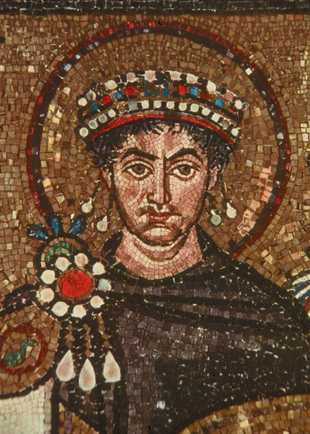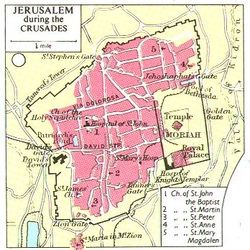Political Influence
Over time, many different religions and groups have fought for control of Jerusalem. The first group that ruled Jerusalem during the middle ages was the Byzantine Empire. During this time (from 527-565) there was relative stability and a steady flow of pilgrims. The emperor Justinian reconstructed Christian buildings such as churches, monasteries, and hospices and built St. Catherine's Monastery and the Nea Basilica.
In the year 614, the Persians invaded. They massacred people and destroyed churches, but in 629, the Byzantines recaptured the city. Then, in 638, the Battle of Yarmuk River began the Arab ruling of the city. This was only six years after Muhammad's death. During this time, the Muslims allowed Christians and Jews to live in Jerusalem, but they had to pay a special tax. The Dome of Rock, a golden dome showing the supremacy of Islam in Jerusalem , was completed in 691. This was the first major Islamic monument. In 762, the capital of the Abbasid Empire transferred from Damascus, Syria to Baghdad, Iraq. This lessened the political importance of Jerusalem and the population and size of the city decreased.
The next Muslim dynasty to rule the city was the Fatimids, who ruled from Egypt from 969 t 1071. In the year 1071, the Seljuk turks captured the city. They decided to block Christian pilgrims from entering, which triggered the Crusades. In 1099, Christian knights arrived, led by Pope Urban II, on the first Crusade. There was a short struggle and the city fell. The Christians would not let Jews or Muslims live in Jerusalem. Mosques were converted to churches, Christian culture became prominent, and French became the everyday language.
Finally, Saladin, a Muslim leader who founded the Ayyubid dynasty, got rid of the crusaders, but they ruled on and off from 1229-1239 and from 1240-1244. In 1247, the Mamluks, a Muslim dynasty from central Asia, took the city. Sanctuaries became Muslim once again. Some Christians stayed in Jerusalem and in 1333, settled in their own quarter of the city. In the year 1517, the Ottoman Turkish sultan Selim I took the city and his descendants ruled the city for 400 more years (Ardito, 44-48) (Website 4).



